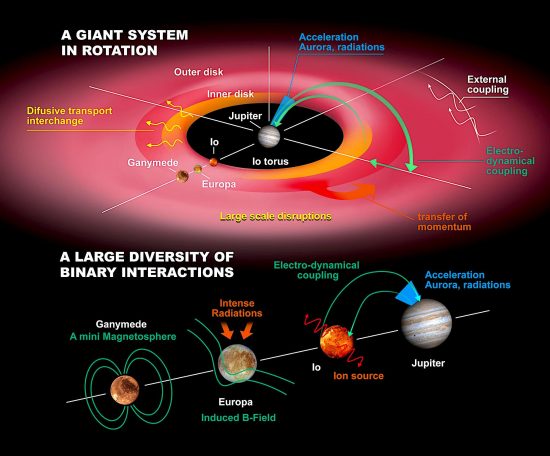
May 7, 2020
Io’s rotation creates radiation that is 1000 times stronger than is needed to kill an unprotected human being.
“Io is the same size as our moon. And should be a cold dead world. Yet our first glimpses of Io revealed it seething with heat, alive with volcanic activity…Something else must be driving that powerful volcanism on Io.”
— Professor Brian Cox, Wonders of the Solar System: Dead or Alive.
In December 1999, when the two Voyager space probes discovered “surprising volcanic activity” on Io, plasma physicist Wal Thornhill predicted that the plumes erupting from its so-called “volcanic vents” would be hotter than any lava fields on Earth. His prediction was confirmed when temperature measurements around the “caldera” exceeded 5700 Celsius.
According to a recent press release, “A large volcanic event was detected on Jupiter’s moon Io…” One interesting comment about the “volcanic” event is that is was “inferred” by observations of Jupiter’s magnetosphere and not by direct observation of any plumes.
Io orbits close to Jupiter, so intense electromagnetic radiation bombards its surface, removing approximately one ton per second in gases and other materials. Io acts like an electrical generator as it travels through Jupiter’s plasmasphere, inducing over 400,000 volts across its diameter at more than three million amperes. That tremendous current flows across its magnetic field into the electric environment of Jupiter.
The plumes seen erupting from Io, rather than volcanic eruptions, are the result of cathodic arcs, electrically etching the surface and blasting sulfur dioxide “snow” up to 600 kilometers into space.
As predicted, the most active regions of electric discharge were found to be along the edges of so-called “lava lakes,” while the remainder of the dark umbras surrounding them are extremely cold. No volcanic vents were found. Instead, the plumes move across Io, as illustrated by the Prometheus hot spot that moved more than 80 kilometers since it was first seen by Voyager 2. The volcanic plumes also emit ultraviolet light, characteristic of electric arcs.
Electric discharges can accelerate material to high velocity, producing uniform trajectories that then “fall out” at a uniform distance. This explains why there are rings around the various caldera. Cathode erosion of Io also provides a reason why the plumes seen highlighted against the black of space possess a filamentary structure, reminiscent of Birkeland currents, discussed many times in these pages.
The Tvashtar “volcano” near the north pole of Io, was seen by the New Horizons probe to be shooting a plume hundreds of kilometers high. A NASA press release reported that “…the remarkable filamentary structure in the Tvashtar plume is similar to details glimpsed faintly in 1979 Voyager images of a similar plume produced by Io’s volcano Pele. However, no previous image by any spacecraft has shown these mysterious structures so clearly.”
“Tidal kneading” is not the cause of Io’s heat. The most probable cause, based on observational evidence and laboratory analysis, is that Io receives electrical input from Jupiter, heating it up through electromagnetic induction.
Stephen Smith












